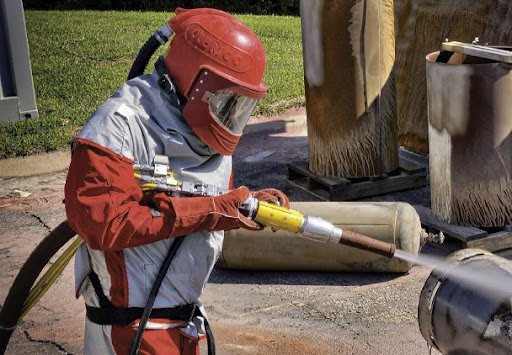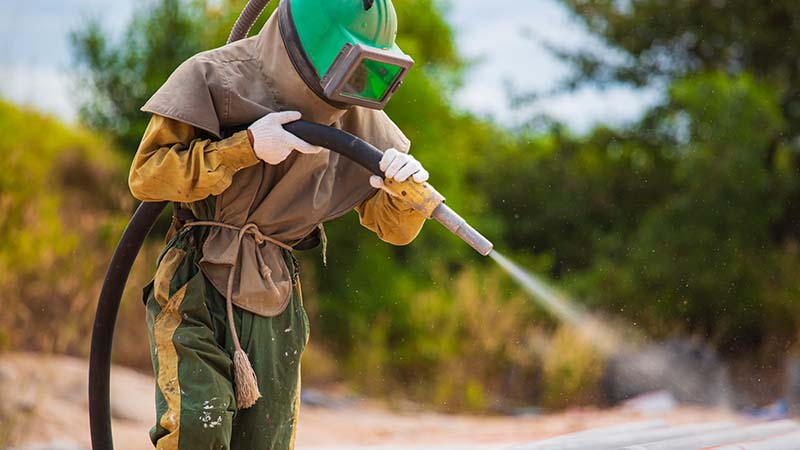Sandblasting is a common industrial process especially required for the oil industry, shipyards, industrial finishing, and others to prepare or clean surfaces. Its widely known as abrasive blasting as well.
Even though it is very used worldwide, there is a huge range of variety regarding the right application, depending on the industry and local conditions.
Since it is a process that, if done incorrectly, can be hazardous and costly it is worthy to learn how to improve it. Also, the very process has evolved over time and every user might need to double-check if an update in their process is needed.
So, let’s get started from the beginning, to reach the right conclusion.
What is sandblasting?
Sandblasting is the process to expel a stream of abrasive material under high pressure against a surface to prepare it. Basically, a sandblaster (the machine) uses pressurized air to hurtle a beam of tiny projectiles (abrasives or media) to remove an undesirable coating, or prep a surface. This process is similar to using sandpaper to smooth a surface, but more even and hugely stronger.
The purpose of this blasting could be to smooth, rough, or shape a surface. Also, removing contaminants, like previous coatings, can be done this way.
The abrasive material, which can be part of a wide selection, is often known as the media. This abrasive can range from walnut shells to glass beads and tiny rock particulates. Some of the most used are steel shots and glass beads.
This media usually is propelled by compressed air, but other fluids such as water or even water steam can be used for that. We are going to see in detail about these process versions, but in the meantime, let’s see how this process that is now known as sandblasting got started.
A little history about Sandblasting
The sandblasting process was invented by Benjamin Chew Tilghman, who patented it on October 18, 1870. The new industrial application was well received by the American Society.
The very next year he was awarded the Great Medal of Honor by the American Institute of the City of New York.
During the following years, he refined the technique and found more uses to be applied to. So, he patented more processes in the US as well as in the UK.
Nowadays, Sandblasting manufacturers keep looking for ways to improve their products, to make them safer, faster and offer cleaner results.

How does sandblasting work
Sandblasting is the controlled erosion of a surface through an abrasive material expelled at high speed by a fluid like air or water.
So, in the natural world sandblasting happens every day, when the wind blows against mountains, for example.
Legend has it that Tilghman (the sandblasting inventor) saw the effects of the wind over landscapes during his days as a soldier in the desert, and got the idea from there.
In modern sandblasting equipment, a recipient is used to mix the abrasive particles with compressed air (or water, in some cases).
This mix now goes out through a nozzle handled by an operator who targets it to the surface in a fashion manner.
There are several types of blasting machines, like blasting rooms, stationary units, cabinets, and portable machines.
As well, there are many types of nozzles, each one with specific uses. But all of them are just for the same operation described above.
Most used abrasives
Some of the most used abrasives, or media, are the following:
- Glass bead
- Crushed glass
- Plastic
- Walnut shell
- Corn cob
- Copper slag
- Aluminum oxide
- Silicon carbide
- Ceramic grit
- Sodium bicarbonate (Soda Blasting)
Most common Sandblasting uses
Among the most common sandblasting uses are:
- Cleaning
- Deburring
- Polishing
- Priming before painting
- Smoothing
- Shaping
- Removal of corrosion
- Removal of rust
- Removal of paint
For what is sandblasting used for
Basically, for cleaning almost any kind of surface. In most cases, to prepare those surfaces to be coated.
Sandblasting can remove extremely fixed dirt, old paints, and all kinds of undesirable coatings a surface may have. Also, sandblasting can smooth rough surfaces, by applying abrasive pressure onto them.
Sandblasting is ideal for concrete, brick, stucco, and more. By using specific abrasives can be used in wood, steel, and more materials as well. According to the abrasive used, it can have a wide range of applications.
Health precautions when sandblasting
Like many other industrial processes, sandblasting may have health-related issues. One is the noise that produces the equipment and the other is a lung disease named silicosis.
First, sandblasting creates high levels of noise. Normally, noise levels when sandblasting range from 85 dBA, which is equivalent to that of a lawnmower running, to 145 dBA, which is equivalent to a shotgun blast. If operators don’t use hearing protection, they can get substantial hearing loss, in a short time.
Second, the risk of silicosis, which is a serious or even fatal respiratory disease is present if it is used any abrasive with more than 1% of free silica. This disease produces scarring and hardening of the lungs.
During windless conditions, a crystalline silica dust particle of 2 microns might drop less than 3 feet in a day. The clouds of this dangerous dust remain floating long after the job is done, being a potential risk to any person around.
The use of silica sand has been prohibited in the UK and other European countries due to this risk. Is advisable to double-check that the media to use contains less than 1% of free silica.
Also, sandblasting can be hazardous due to dust levels and toxic metals generated from both the abrasive blasting material and the underlying substrate and coatings being blasted.

How to face health-related issues
Before starting the job, all the hazards that can be faced should be identified. This way the operator can know what they need to wear as personal protective equipment and for respiratory protection.
Personal protective equipment should include safety goggles, respirators, coveralls, and helmets especially designed and inspected for sandblasting operations.
Some companies use containment or ventilation to reduce exposure to abrasive hazards when sandblasting.
It is ideal to schedule blasting operations when fewer people are present in the place. Another option is to use curtain walls or blast rooms to keep sandblasting operations away from the staff, if possible.
As a summary, some safety measures that can be taken are:
- Inspect all hoses and connections regularly. Replace any that are worn or damaged before next use.
- Avoid sandblasting in windy conditions to prevent the spread of any hazardous materials.
- Provide personal protective equipment to operators accordingly to the job.
- Prohibit eating, drinking, or using tobacco products in blasting areas.
- Provide wash stations so workers can wash their hands and face routinely and before eating or drinking.
- Substitute toxic or hazardous abrasive blasting materials with less toxic or hazardous alternatives.
- Perform routine cleanup using wet methods to minimize the accumulation of toxic dust.
- Conduct safety training regarding sandblasting regularly.
Types of equipment for sandblasting according to process
Even though nowadays sandblasting is mainly carried out by using compressed air, some innovators and companies have created machinery that offers a variety of processes. Let’s consider some examples:
Wet blasting
Recently, some sandblasting equipment manufacturers have created versions of their machines that, instead of using compressed air, require water to expel the abrasive.
The idea of this equipment is to substitute the total or partial use of compressed air with water. Other equipment uses vapor (water steam) to propel the particles. In both cases, they named this process wet blasting.
This doesn’t mean that this process is dustless. There is no such thing as dustless sandblasting. Don’t be fooled by that promise. Actually, after using wet blasting you will need to handle a water pudding right in the place you are working on.
Vapor blasting
This is a version of wet blasting in which the media is expelled by the use of vapor (water steam) instead of just water or even compressed air.
The manufacturers of these types of equipment claim that the cloud of dust is reduced drastically. But in any case, as stated before, the cloud of dust is never eliminated.
What is Soda Blasting?
This is the name that receives a mild form of sandblasting in which the media is sodium bicarbonate particles. This abrasive -also known as baking soda- is sprayed to the surface by using compressed air.
Due to its properties -can clean and deodorize- is it ideal for wooden surface cleaning and restoration. Since is a non-destructive method, can be used in many applications that require a delicate touch, like:
- Building restoration
- Automotive restoration
- Cleaning
- Graffiti removal
- Rust removal
- Boat hull cleaning
- Paint stripping
- Equipment maintenance
- Food processing plants
- Laboratories
- Fire damage removal
- Wooded areas cleaning
The sodium bicarbonate particles are easy to crumble and normally, when sprayed, can take down the coating without causing damage to the surface. Since it’s a soft material, pressures to blast it are very low, like 20 PSI on average.
Sponge blasting
The difference in this version is the abrasive material, which in this case is sponge bits. When the sponge particles impact the surface, they create a vacuum and capture the material that needs to be removed.
After that, the used material can be recycled for separate coating from abrasive and get ready for the next job. This way, according to its manufacturer, hazardous dust can be reduced up to 98% and savings from recycled abrasives can reach 96%.
Types of equipment for sandblasting according to capacity
The equipment available for sandblasting can be divided into portable, stationary, and blast rooms.
Portable equipment
This is the equipment to obtain when the needs of the company require mobility. Usually, they are powered by an air compressor and include one or several blast pots, where the abrasive material is held.
The mobility gives an advantage over other systems, to cover small or hard-to-reach places. These are some examples.
Stationary equipment
Also known as blast cabinets, in this category, we can include sandblasting equipment of different sizes and capacities.
A blast cabinet for sandblasting is usually composed of a compartment for the abrasive material, the recycling system, and the dust collection.
Some of these are completely stationary, while others can be put into a trailer for mobility purposes. These types of blasting machines are ideal for long jobs. These are some examples.
Blasting room
This is the largest version of sandblasting equipment. It consists of an entire room where one or more operators can work. The principal objective is to remain sealed and avoid abrasive material to escape.
Vehicles, construction and military equipment, aircraft, and other big-size equipment and surfaces can be blasted in there.
Like in the case of the stationary equipment, it is usually composed of a pot for the abrasive material, and a recycling and dust collection system.
You are not alone in this
We, the people at Ifexport, have been working with industrial processes, like sandblasting, since 1979. So, we can tell you one thing or two about it. Helping our clients to get covered with their sandblasting needs is one of our goals. We can’t wait to apply our expertise to your workshop also.






This Post Has 2 Comments
It really helped when you mentioned that every equipment and sandblasting place should be inspected for a proper and safe function. Last night, my workmate told me he was looking for a reliable sandblasting room service that could offer site preparation and inspection to create a sandblasting surface for our business workplace development. He asked if I had thoughts on the best sandblasting room guide for a proper approach. Thanks to this informative sandblasting guide article for the best sandblasting process. I’ll be sure to tell him that it will be much better if we consult a trusted sandblasting company as they can answer all our sandblasting inquiries.
I liked how this post wrote that some sandblasting equipment requires water to expel the abrasive. My friend wants to opt for mobile dustless blasting. I should advise him to go for it to ensure reliable work.